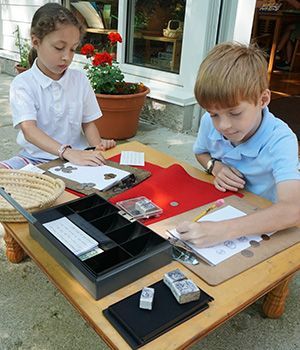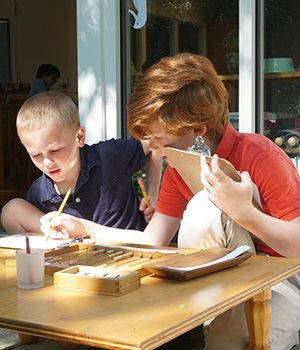
A Tough Topic for Many, an Essential Topic for All
Money can be a topic wrought with emotion and social confusion. Children pick up on the ambiguity, the uncertainty, and the power of this mysterious subject—one that they encounter, in some way or another, almost daily. How do parents introduce them to this aspect of their adult lives? How do parents explain the complex feelings they themselves may have about the subject? Talking to children about money—something that for an adult might involve feelings of shame, insecurity, or maybe even resentment—can be challenging. Parents can try to stay on a surface level in conversations, but children pick up on the emotions and judgment that lie just beneath that surface. Wherever they consider themselves to be on the financial security/success scale, parents can’t get away with being vague for too long.

As Ron Lieber explains in The Opposite of Spoiled, whether a family is high or low or somewhere in between on the national scale of incomes, not talking to children about money is failing them. Instead, he says, embrace the opportunities to pass on life values. He encourages parents to start discussing the subject even if they haven’t figured it all out for themselves yet. Just get started and work through it, he advises.
Talking to children about money is complicated further by a constant barrage of messages from others—from the media and advertisements that are everywhere that children turn. Lieber calls this an “engine of envy” and a “torrent of longing” that presents temptations to children and young adults every day. If parents don’t say much, children will form their values from elsewhere.
Montessori and Money

Dr. Montessori embraced this topic as a fascinating study in human exchanges and agreements. She encouraged educators and parents to let children handle real coins and paper money, and to study how different civilizations created monies to address issues that arose with trading goods and exchanging. In the Lower Elementary Montessori classrooms, 6-to-9-year-olds use real coins and paper money for counting and making combinations that are relevant in current culture. Children work through mathematical equations using money combinations and solve word problems about real-life situations. This gives them familiarity and confidence with the subject on basic levels. They also learn about economic geography by studying where certain goods are manufactured in our country and in the world, using stamps to create their own ink maps. They study the progression and transformation of goods, such as wheat as it is made into bread. The children investigate all the persons who are involved in such processes, from the miller, to the baker, to the storekeeper, to the truck drivers, and so on. This builds an attitude of appreciation and an understanding of economic sequences and relationships.
In Upper Elementary Montessori classrooms, children ages 9-12 learn more about world economies and taxes, and through some presentations from their teachers as well as their own studies of different topics, their knowledge and understanding of finances grows.

In the Secondary Level, adolescents in Montessori programs begin to make crafts and sell them to participate in a local economy and raise funds for various school activities. They plan service trips that require a detailed budget, created by a student finance committee. At Forest Bluff School, students also balance their own classroom account and walk to the local bank to make deposits and withdrawals. The Secondary Level adolescents’ discussions about the financial world extend from articles in the periodicals that come to the classroom daily, including the Wall Street Journal that relays the stock market activity and The Economist that gives a global perspective on issues of the day.
Talking About Values
It is crucial, however, that parents and extended family members address the topic of money from home and outside of school as well. Wise mottos on this subject are easy to find. Basic ones every child can benefit from are:
- Spend less than you make. Money can create interest when in the bank where it is being used and builds interest over time. Borrowing money means a person is spending more, not less, and companies might benefit if they can entice a person to spend.
- Build a work ethic throughout life. From a Montessori perspective, this begins at birth, believe it or not! It is about valuing effort in the infant who is trying to do something for herself or himself. Parents help their child immeasurably, for instance, when they patiently and unobtrusively support a 15-month-old who is attempting to button her own shirt or pull on her sock. The simple act of giving the child the time and space to dress herself (rather than take control of the situation because it’s faster and easier for the parent) establishes a precedent for the child that she is already an independent, capable being who can accomplish great things with focused effort. These early experiences with self-reliance and persistence lay the foundation for a strong work ethic and a can-do attitude. At each stage of childhood, there are relevant challenges that adults can support their children to embark on, encouraging a strong work ethic from the beginning.
- Money is about human values, not about stuff. Everyone knows the sayings Money can’t buy you happiness and You can’t take it with you, but the behavior children see all around them competes with these ideas. It’s important to discuss advertisements with children to help them develop the ability to take a step back and discern accurately.
Today’s surrounding culture will give children ample soil for developing their views about money. This is why it is so important for parents to talk about the subject and to see the conversations as wonderful opportunities to pass on enduring values.
Young Children
With very young children, this can be done simply by modeling values in one’s daily choices and activities. A parent can begin thinking about why he or she made simple decisions, such as whether or not to purchase something—a certain food over another, for instance. A parent can do this, knowing that before long, their young children will articulate these very questions in the form of “Why can’t I have that Pop-Tart instead of this orange?” When they ask such questions, a parent might answer, “It is important to me to give your growing body the nutrition it needs to be healthy and happy. That’s my job as your parent.” (Note: This is a statement that involves no negotiating! If these are personal values, then they belong to that person. Realize, the parent is in charge of this, not the children.)
Elementary, Ages 6-12
As children get older and they notice their parents buying their clothes at a discount store instead of where a friend goes shopping, this is an opportunity for parents to verbalize the choice. A parent can steer answers towards their values. Instead of saying “we cannot afford…” or passing judgment on what “other people” do, a parent can explain that they want to have money for other things that they value more than name-brand clothing. This models and exposes children to decision-making and personal values.
When children ask their parents, “Why does that man drive an expensive car?” that parent has an opportunity for a discussion, which can always lead back to what they value and how their values are shaped. Adults can honor other people’s choices nonjudgmentally, since one often doesn’t always know why other people make the choices they make. A parent may decide to share the message that “the most important things in life are not
things—they are experiences and people and stories.” And yes, sometimes these are represented by things, but they are not the things themselves.

Beyond the commercially-produced games that one could buy that teach children about money, parents can make up games with coins and dollars, to help their children learn about finances. For example, in The Seven Habits of Highly Effective Families, Stephen Covey explains a game one family played to help their children learn basic principles of finance right in their own living room. In sum, they set up the room with four stations: a pretend “bank,” a “store,” a “credit card company,” and a “charity” stand. Starting a stopwatch to keep track of the time, they gave the children “jobs” to do, such as folding laundry and sweeping, and then paid them a dime for doing this work every few minutes when a timer went off. Then the stopwatch alarm went off again, and the parents stopped the children to let them either spend their dimes at the store, use it to borrow more from the credit card company, put it in the bank, or some combination. They resumed the work cycle, and then another bell went off, signaling time to collect on—or distribute—interest! Experiencing what happens when one has borrowed, versus seeing the money grow in the bank, made these children understand something that many adults still have trouble getting used to! The promises that come in the junk mail about how “easy” it might be to spend money one does not actually have may be leading a generation of young people to confusion. But by talking about this and playing simple games, parents can get the basic ideas across and have fun doing it.
Adolescents and Young Adults
Adolescence is when the more subtle and complex aspects of investing, taxes, money management, and economies in the wider world become fascinating. Adolescents are beginning to realize they will need to be independent from their parents someday, and the internal feelings can be daunting. They need conversations about how it all works and how they are going to make their own way in the future.

At Forest Bluff, we encourage families to tell their adolescents ages 12 to 15 that these are “skill building years” when they should not expect to be paid, but should seek out internships, apprenticeships, and jobs in businesses outside of their family circle. This way, young adults learn customer service, how to talk with strangers, how to be helpful, how to get a job done well, what people value in the workplace, and how it all works. Most importantly, they get to be a part of it.
Young workers will see people from all walks of life. They’ll notice those who take constant cigarette breaks and those who stay late to finish packing boxes. They’ll come into contact with rude customers and might witness random acts of kindness as well. By showing up on time and acting responsibly, adolescents may be promoted to working behind the desks or interacting with customers. Many will find that employers want to pay them when they find that their work contributes and that they are dependable. It can take time to prove oneself, and this is, in itself, a lesson of how the workforce operates. Having one’s contributions valued is incredibly validating for a young person. Starting at these jobs by working for free in their early teens typically leads to building skills that make children employable at sixteen—the age when others might be trying to find a job for the first time, with no real experience under their belts.
A Family Culture Moving Forward
Families that talk about their values and about money, who plan together and work like a team to support one another, will find that finances can be a natural part of their family lives. Parents are wise to talk with their children about what determines the true wealth of any family: These can be thought of as human capital, intellectual capital, financial capital, and social capital. On any level, a family can look at what areas they may need to invest in: intellectual capital means education, experiences such as camps or courses, eventual careers, and the coaching and mentoring the family might be able to invest in. Social capital has to do with philanthropy and helping others in one’s communities, whether by giving time and volunteer energies, or with financial donations (The Legacy Family, Hausner & Freeman).
A common question is whether children ought to be paid for chores. The research shows strongly that paying children for actions that ought to be normal parts of daily living—such as tidying up one’s things, helping to make meals, carrying groceries into the house, or taking out the garbage when it is full—backfires. Is anyone paying the adults in a family to do these things for the rest of the group? If children are paid, then how are they being prepared for normal adulthood? Studies show that children who do choresfor which they arenot paid are happier, healthier, and more successful, not only in life but academically as well. Contributing to the life of one’s family or group builds values and character, a collaborative mentality, and maturity. It prepares them for life.
Making It Last
Parents may choose to avert their family’s attentions from making opinions about money or judging the decisions of friends, and instead focus on the idea of passing on values from generation to generation. A warning to wealthy families comes in the proverb of “Shirtsleeves to shirtsleeves in three generations” or “Rice paddies to rice paddies…” or “Orange grove to orange grove…”. In any culture around the globe, there is a common pattern of younger generations losing the wealth passed on to them. If given money without learning to carefully and conservatively build financial stability, a family can lose the work ethic and values that created the success in their previous generations. So, this passing on of values should be a constant concern in any family, wealthy or not. Every parent hopes to raise children who can build financial security and prosperity in adulthood. A focus on values guides parents to think about the realities of adulthood when making decisions with their children and discussing money. In the Montessori approach, the goal is not to educate children for another level of schooling, but for life!
Dr. Montessori said about money:
"It is clear that we cannot give all these different notions that ought to be developed to the child all at once, but one should give practical possibilities of studying the different sides and by means of material, gradually go through the different stages throughout the ages…you will see how easy it is to render clear to the child these first fundamental steps…It forms a real study that must develop gradually as all the other studies do" (1939 AMI Journal article from Montessori archives).
So, in the spirit of the Montessori approach that encourages us to connect with our children on all subjects, talk about money this summer, play some games, and embrace the opportunities to express your heartfelt life values with your children.
Suggested Reading
The Opposite of Spoiled: Raising Kids Who are Grounded, Generous, and Smart About Money, by Ron Lieber
The Seven Habits of Highly Effective Families, by Stephen Covey
The Legacy Family: The Definitive Guide to Creating a Successful Multigenerational Family, by Lee Hausner and Douglas K. Freeman
(This book includes an excellent list of suggested books towards the end.)
Wealth and Families: Lessons from my Life Journey, by Howard Stevenson
(A faculty member and leader at the Harvard Business school for 40 years and founder of a wealth management firm. This simple little guide was written to give advice to his own family, but it offers wisdom for any situation.)
Silver Spoon Kids: How Successful Parents Raise Responsible Children, by Eileen Gallo and Jon Gallo
Better than a Lemonade Stand: Small Business Ideas for Kids, by Daryl Bernstein
Games for Children
The Game of Life by Hasbro
Cash Flow for Kids by Robert Kiyosaki


